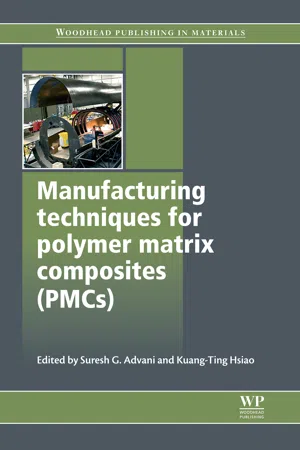Manufacturing of polymer matrix composites (PMCs): short fiber and nanomaterial based processing
Abstract:
This chapter introduces the range of manufacturing processes for polymer matrix composites discussed in detail in the book Manufacturing techniques for polymer matrix composites (PMCs). It discusses short-fiber composite molding processes, such as injection and compression molding, as well as the processing of polymer nanocomposites. The chapter also highlights high-viscosity thermoplastics-based processes such as sheet forming, thermostamping and filament winding. Finally, the chapter considers processes for thermoset matrices such as resin transfer molding, pultrusion, autoclave and out-of-autoclave processing.
1.1 Processing of polymer matrix composites
Polymer matrix composites consist of particles or fibers embedded in polymer matrices. The particles or/and fibers are introduced to enhance selected properties of the composite. The particles on the micron scale usually provide better thermal stability and toughness whereas particles at the nano scale such as nanoclays can improve physical and mechanical properties. Long aspect ratio particles such as whiskers and short fibers or continuous fibers are added to reinforce physical and mechanical properties. Continuous fiber reinforcements usually provide the highest improvement in mechanical properties such as stiffness and strength and can be introduced in various forms such as continuous random mat, woven fabric, and stitched fabric, unidirectional or bidirectional fabric. The polymer matrices addressed in this book are thermosets and thermoplastics. The fiber material is usually glass, carbon or aramid. Often these materials are introduced in a precursor form in the manufacturing process. The precursor form usually mixes the fibers and resin in the form of a pellet (short fibers embedded in a solid matrix) or prepregs (continuous fibers with resin attached to them in terms of a powder or pre-impregnated partially cured resin). For further reading on types of reinforcements and various forms available, we refer the interested reader to chapters in other textbooks on the topic.1–4
Although the properties of the reinforcing phase have a significant influence on the final properties of the composite, the quality of the starting material form and the processing route selected to manufacture the composite can impact the final properties and performance of the composite. The goal in composite manufacturing is to produce components with the desired properties that combine the best properties of the fibers (or particles) and the resin while masking or minimizing their weaknesses. Nowhere is this truer than in composite manufacturing where one makes the properties while manufacturing the part. This is true for short fiber composites as well as continuous fiber composites. For short fiber systems, the processing history and material properties can influence the final fiber orientation and distribution density, which is guided by the flow, and can result in non-homogeneous properties in the final component. For continuous fiber systems, the challenge during making the composite is to fill all the empty regions between the fibers with resin so there is good matrix–fiber interfacial bonding, which is essential to prevent delamination and avoid crack initiation under applied loads.
The composite manufacturing industry has always recognized the importance of initial material forms and processing for part performance and over the last three decades there have been (i) improvements in material chemistry such as reduction in the viscosity of resin, delayed curing of the resin, or fabrics that are easily conformable, (ii) improvements in existing composite manufacturing processes or introduced new processes and (iii) the industry has resorted to more science-based processing than the trial and error prevalent manufacturing approach to mitigate the cost of manufacturing and make composite materials more competitive with their metal counterparts. Hence over the years many reference books have been written to summarize the advancement of the science by researchers and practitioners in the field.5–8 In the last two decades, modeling and simulation textbooks, tools, and courses have been introduced to provide science-based understanding of these complex material interactive behaviors as they combine to form a composite with superior properties.1–8 As a result, polymer composites are continuing to replace their metal counterparts in many industries from defense to infrastructure due to their lower weight (which usually translates into energy savings) and corrosion resistance (which is attractive for durability and lifetime cost savings). This book is a collection of chapters by various experts in selected composite manufacturing processes. The general approach followed for each chapter is for the authors to (i) describe the process, its benefits and challenges, (ii) provide a window into our current level of understanding of the material behaviors and processes and (iii) introduce the tools for improving the manufacturing of composites.
There are many different manufacturing processes that have evolved to fabricate polymer matrix composites. These processes were modified or developed to address various needs such as (i) new fiber or matrix systems, (ii) new and improved initial precursor material forms, (iii) composite part geometrical constraints, (iv) cost-effectiveness, (v) multi-functionality of the part, (vii) enhancement of a specific physical, electric or mechanical property and (viii) defect constraints. The composite industry continues to engage in the development of new manufacturing processes that will allow them to fabricate composite parts with higher quality, reduced cost, and embrace emerging opportunities such as new reinforcement systems and new polymer matrix systems. In addition to the development of new processes, the adoption and the utilization of the fundamental science in the manufacturing processes have accelerated the improvement of the manufacturing technologies. Scientific approaches along with analytical modeling and numerical simulations are better utilized today to predict the physics and reaction during the manufacturing processes before investing in the prototype manufacturing and testing. The variability from one part to the next can also be reduced by improving material forms and introducing processing methods that can produce defect free parts with desired properties, despite ...
